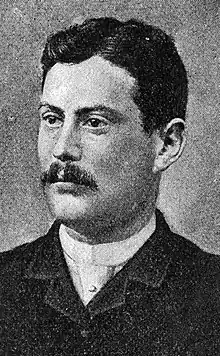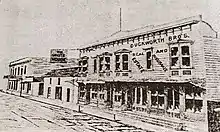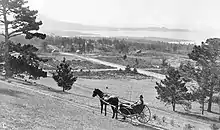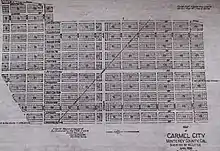Santiago J. Duckworth
Santiago Jacob Duckworth (June 13, 1865 – June 28, 1930), known locally as S. J. Duckworth, served in the California State Assembly for the 61st district from 1893 to 1895.[1] He was as an early Monterey pioneer businessman, real estate developer, and visionary of the short-lived Carmel City. In 1889, he wanted to build a Catholic summer resort, bought the rights to develop the area, filed a subdivision map, and started selling lots.[2] After an unsuccessful undertaking, he sold the property to James Franklin Devendorf in 1902, who went on to found the Carmel Development Company and Carmel-by-the-Sea, and the Carmel Highlands in California, United States. Duckworth helped shape the early development of Carmel, bringing the first major developers and builders, and attracting some of the first residents.[3]
Santiago Duckworth | |
|---|---|
 Santiago J. Duckworth (1862–1930) | |
| Member of the California State Assembly from the 61st district | |
| In office January 2, 1893 – January 7, 1895 | |
| Preceded by | Alexander Brown |
| Succeeded by | William George Hudson |
| Personal details | |
| Born | Santiago Jacob Duckworth June 13, 1865 Monterey, California, US |
| Died | 28 June 1930 (aged 68) Tucson, Arizona, US |
| Spouses | Flora McKinlay
(m. 1896; died 1903)Eloisa Maria Pinto (m. 1909) |
| Children | 2 |
| Occupation | Real estate development |
Early life
Duckworth was born on June 13, 1865, in Monterey, California.[4] His mother, Josefa Romero (1834-1931), was the daughter of José Figueroa the Mexican Governor of Alta California from 1833 to 1835.[5] His father was Lorenzo Santiago Duckworth (1831-1871). Lorenzo's mother was Antonia Armenta, whose father, José María Armenta, held the land grant to Rancho Point Pinos.[6][7] He lost his father at the age of six. With his two older brothers, they were sent to Watsonville Orphan Asylum in Watsonville, California where they were educated by Fransican Fathers. At the age of eleven Duckworth he left to support his widowed mother.[4]
On November 29, 1892, Duckworth married his first wife, widow Flora Manuel (1852-1903), daughter of Carmen Amesti McKinley (1824–1901) and James McKinley, at the St. Mary's Catholic Cathedral in San Francisco. Carmen Amesti was the daughter of Jose Amesti, who owned Rancho Los Corralitos a Mexican Land Grant.[8] She died at a hospital in Watsonville, California, at 45 years of age, on October 19, 1903.[9] He married his second wife, Eloisa Maria Pinto (1885-1961) on June 23, 1908, at the home of the bride's parents in Watsonville. Father P. D. Hassett, from the St Patrick's Catholic Church, gave the blessing at the wedding.[10]
Professional background
In January 1883, Duckworth took a job at the Western Union in San Luis Obispo, California. He then moved to Nogales, Arizona in 1884, to work for the Mexico Railway Company and the Federal Telegraph Service in Sonora, California where he got the title of "Chief Operator." In 1886 he returned to Monterey.[7] In 1887, he worked in real estate in Monterey with his brother, Belisario E. Duckworth (1858-1917).[4]
Politician
In April 1890, he accepted the position as Deputy City Clerk of Monterey. In July 1890, he made an unsuccessful run for the Republican Party's nomination to the California State Assembly from Monterey County.[7] He ran again in November 1892 and was nominated by Judge R. B. Carpenter for Monterey and was elected as a Republican to the State Assembly. He was a member of the California State Assembly for the 61st district from January 2, 1893, to January 7, 1895. He ran on the Republican ticket and was a Republican for most of his life.[11][1][12][13]
On March 19, 1898, Duckworth was appointed deputy collector of customs under Harry Chenoweth at Nogales, Arizona.[14]
Carmel City


In 1887, he and his brother, Belesario Edward Duckworth, set up a real estate and insurance company, named Duckworth Brothers on Alvarado Street in Monterey.[15] By February 1889, the business was renamed from Duckworth Bros. to D. J. Duckworth, Real-Estate, Insurance Agent. In December of that year he added "Notary Public" to the billing.[2]
On January 9, 1888, the Pacific Improvement Company wanted to extend the railroad from Monterey to the Carmel River. Duckworth wanted to use this railway to establish a Catholic retreat near the Carmel Mission, in Carmel. The Catholic retreat would be like the Methodist colony already in Pacific Grove, California and would be called "Carmel City." This tract of land was known as Rancho Las Manzanitas. In 1888, Duckworth approached French businessman and Monterey businessman Honoré Escolle, with his plan of building the Catholic Community.[16][17]
On February 18, 1888, Escolle signed an agreement to sell 324 acres (131 ha) to Duckworth and his brother. The land began at the top of the Carmel Hill and ran past Hatton Ranch, down through Ocean Avenue to Junipero Avenue.[18][19][16]: p4
In 1888, Carpenter Delos Goldsmith built Duckworth a one-story Vernacular-style side-gabled redwood residence, now known as the Santiago Duckworth House. The house is located on Carpenter Street southwest of 2nd Avenue. It was one of the first homes constructed in Carmel City. Goldsmith was the first builder in the new community.[20][21][22]

In March 1888, Duckworth authorized W. C. Little, of Monterey, to survey the Carmel property and write down a subdivision map of the townsite with 135 blocks divided into four tracks. On May 1, 1888, the map was registered with the County Recorder of Monterey County. Corner lots were twenty-five dollars and inside lots twenty dollars and business lots solf for fifty dollars. In July 1888, the sale of lots began.[2][3]: p15

In 1889, Chinese workers began make the ground level at the end of the railway line. In April 1889, Duckworth placed an announcement in the local newspapers for the sale of Carmel lots, highlighting the advantages of the lots, access to the Southern Pacific railroad.[2] Chinese and Hispanic laborers cleared shrubs and marked off the lots. Cottages were built and business were started.[15]: p93 [3]: p15
On July 1, 1889, Duckworth sold seven lots. In December 1889, he had sold another 207 lots and reserved five lots on the north side of Broadway Avenue (now Junipero), between 6th and Ocean Avenue for Carmel City's first hotel, Hotel Carmelo (now the Pine Inn). Most of the people that bought these lots were school teachers and administrators from San Francisco. However, the railroad was only extended from Monterey to the Asilimar in Pacific Grove, California.[7]
Duckworth hired Abbie Jane Hunter as a sales agent for Carmel City, who had founded the Women's Real Investment Company in San Francisco.[19]: p27 In 1892, she sent out postcards promoting Carmel City as Carmel-by-the-Sea. References to Carmel City as a Catholic resort were never used again. She created a bath house at the foot of Ocean Avenue in 1889. It had a cupola and windows across the front to view the ocean. It was torn down in 1929.[23]
On November 17, 1892, Duckworth decided to go into politics and directed all of his unsold lots to Escolle as agent.[7]
In Panic of 1893 the United States went into a five-year depression that began in 1893 and ended in 1897. Sales were stagnant and the Carmel project was losing money. Hunter's agents, Dummage and Goldsmith, managed to sell three hundred more lots in Carmel. By 1895, the business of selling lots got did not improve. By 1900, Ms. Hunter's Carmel enterprise was almost bankrupt.[7][16]: p5
In 1902, real estate developer James Franklin Devendorf purchased all the unsold land in Carmel from Duckworth with financial backing of San Francisco attorney Frank Hubbard Powers who became his partner. They formed the Carmel Development Company on November 25, 1902, and established the artists and writers' colony that became Carmel-by-the-Sea, in 1903.[3][16]: p8
In 1903, Duckworth moved from Monterey County to Watsonville and had a 178 acres (72 ha) ranch near Pinto Lake in the Pajaro valley, about three miles northeast of Watsonville. He kept the reach until March 1915, when it was foreclosed for half its value.[24] In August 1915, he was elected secretary of the Watsonville Chamber of Commerce.[25]
Death
Duckworth returned to Arizona in early 1930 to manage the campaign of Senator Andrew Jackson Bettwy for the Democratic nomination for governor of Arizona. He was also an editor of the Arizona Democrat, a political paper.[26]
Duckworth died of typhoid fever in Tucson Arizona on June 28, 1930, at the age of 68, at the St. Mary's hospital.[11]
References
- "California - S. J. Duckworth". joincalifornia.com. Retrieved 2022-03-09.
- "Carmel City. Great Enterprise of a Montereyan. S. J. Duckworth's Plan to Build Up a Catholic Summer Resort". Monterey Cypress. Monterey, California. 14 Dec 1889. p. 7. Retrieved 2022-03-07.
- Grimes, Teresa; Heumann, Leslie. "Historic Context Statement Carmel-by-the-Sea" (PDF). Leslie Heumann and Associates1994. pp. 15–16. Retrieved 2022-01-18.
- Renison and Farley (1894). Resources of Monterey County Midwinter Fair Edition. p. 14. Retrieved 2023-01-04.
{{cite book}}:|work=ignored (help) - Weber, Francis J. (1991). Prominent visitors to the California missions, 1786–1842. Dawson's Book Shop. ISBN 9780874619331.
- Ogden Hoffman, 1862, Reports of Land Cases Determined in the United States District Court for the Northern District of California, Numa Hubert, San Francisco
- "Santiago Duckworth". carmelbytheseaca.blogspot.com. Retrieved 2022-03-08.
- "Duckworth-Manuel". The Californian. Salinas, California. 29 Nov 1892. p. 3. Retrieved 2022-03-09.
- "Death of Mrs. S. J. Duckworth". The Californian. Salinas, California. 20 Oct 1903. p. 3. Retrieved 2022-03-08.
- "Wedding In The Shadow. Dying Father Gave His Daughter His Final Blessing". The Californian. Salinas, California. 24 Jun 1908. p. 4. Retrieved 2022-03-08.
- "Typhoid Takes Bettwy Editor". Tucson Citizen. Tucson, Arizona. 28 Jun 1930. p. 1. Retrieved 2022-03-08.
- "The Legislature. Indications That The Democrats Have a Majority". The San Francisco Call. San Francisco, California. 10 Nov 1892. p. 2. Retrieved 2022-03-09.
- "A Final Clinch, Placed on the Work of the "Machine."". The Los Angeles Times. Los Angeles, California. 30 Jul 1892. p. 1. Retrieved 2022-03-09.
- "Duckworth's New Job". Arizona Republic. Phoenix, Arizona. 20 Mar 1898. p. 1. Retrieved 2022-03-09.
- Dramov, Alissandra (2013). Carmel-by-the-Sea, the Early Years (1903-1913). pp. 92–93, 95, 113. ISBN 9781491824146. Retrieved 2022-03-08.
{{cite book}}:|work=ignored (help)CS1 maint: location missing publisher (link) - Hale, Sharron Lee (1980). A tribute to yesterday: The history of Carmel, Carmel Valley, Big Sur, Point Lobos, Carmelite Monastery, and Los Burros. Santa Cruz, California: Valley Publishers. pp. 4–5. ISBN 9780913548738. Retrieved 2022-01-18.
- Fink, Augusta (2000). Monterey County: The Dramatic Story of its Past. Valley Publishers. p. 202. ISBN 9780913548622. Retrieved 2020-07-19.
- "Carmel City. The Beautiful Spot Decided Upon For a Catholic Summer Resort". Monterey Cypress. Monterey, California. 20 Apr 1889. p. 1. Retrieved 2022-03-09.
- Seavey, Kent (2007). Carmel, A History in Architecture. pp. 26–30. ISBN 9780738547053. Retrieved 2022-01-16.
{{cite book}}:|work=ignored (help)CS1 maint: location missing publisher (link) - "Homes of Famous Carmelites" (PDF). ci.carmel.ca.us. Carmel-by-the-Sea, California. 1992. Retrieved 2023-04-11.
- "Carmel Inventory Of Historic Resources Database" (PDF). The City of Carmel. Carmel-by-the-Sea, California. Retrieved April 9, 2023.
- Dramov, Alissandra; Momboisse, Lynn A. (2016). Historic Homes And Inns Of Carmel-by-the-Sea. Carmel-by-the-Sea, California: Arcadia Publishing. p. 88. ISBN 9781467103039. Retrieved 2023-04-02.
- Gilliam, Harold; Gilliam, Ann (1992). Creating Carmel: the Enduring Vision. Salt Lake City: Peregrine Smith Books. p. 14. ISBN 9780879053970. Retrieved 2022-03-10.
- "Great and Rich Ranch Sacrificed At Trustee Sale". Santa Cruz Evening News. Santa Cruz, California. 30 Mar 1915. p. 5. Retrieved 2022-03-09.
- "Duckworth A Good Man For the Place". The Californian. Salinas, California. 25 Aug 1915. p. 8. Retrieved 2022-03-09.
- "Former Arizonan Fights for Life Against Typhoid Attack". Arizona Daily Star. Tucson, Arizona. 28 Jun 1930. p. 1. Retrieved 2022-03-08.